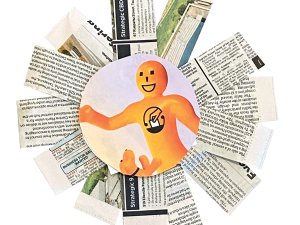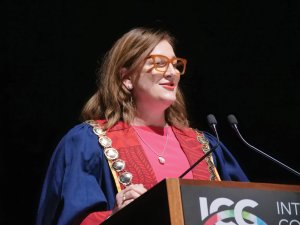Respiratory physician Lutz Beckert considers chronic obstructive pulmonary disease management, including the prevention of COPD, the importance of smoking cessation and pulmonary rehabilitation, and the lifesaving potential of addressing treatable traits. He also discusses the logic of inhaler therapy, moving from single therapy to dual and triple therapy when indicated, as well as other aspects of management
Rare and endangered: The global GP
Rare and endangered: The global GP

Once thriving, the lesser-spotted general practitioner needs a fan base and a protected habitat, writes editor Barbara Fountain
And some may not even know they want to be rescued. There’s some safety to be had in those white and chrome corridors where the patients don’t remember your name
If global primary care were an action movie, Jason Statham would be tasked with an extraction, getting GPs and their ilk out of hospitals.
With his cadre of specially trained, blackbedecked operatives, Statham would enter by stealth; my guess is through the ambulance bay – it’s a popular option.
Finding the GPs, aka family doctors or primary care physicians, won’t be easy because their captors will have dressed them in white coats. In other words, they will look like, and often mimic the actions of, the hospital doctors.
And some may not even know they want to be rescued. There’s some safety to be had in those white and chrome corridors where the patients don’t remember your name.
But in this movie, Statham will extract the GPs and deliver them into the arms of their community, where they belong, where they will be welcomed and cherished for the exotic, endangered creatures they are.
Fantasy, surely?
Taking out the 2500-odd representatives from Australia, about 1500 delegates from 107 countries attended the recent World Organization of Family Doctors conference in Sydney.
But for 48 of those countries, the number of delegates was three or less. You could blame the long-distance travel to the Antipodes, but more likely, the numbers reflect the infancy of the generalist specialist in many countries.
As Fiona Cassie reports in this issue, generalists in countries like Kenya, the Philippines and Azerbaijan are a relatively new and feisty breed, often finding themselves confined inside hospital walls, with a health-system hierarchy staunchly oblivious to the well-documented benefits of doctors working in the community with long-term relationships with patients. Instead, in some countries, family physicians watch on as the patients and their respective body parts are shuttled from one specialty to the next, with no one quite pulling the whole together.
A colleague reading of these global endeavours commented: “I didn’t realise our system of general practice was so unique.”
It is. On the global stage, having a specialist GP working in a community setting is confined to a small number of countries – the likes of the UK, Canada, Australia and west European countries.
Having a specialist GP working in a community setting with the support of a multidisciplinary primary care team, as happens in New Zealand, is a rare phenomenon and, as we are aware, an endangered one.
If general practice were a bird, it would have its own campaign with an endearing but urgent voiceover by Sir David Attenborough. The “bird” that stays with you and your family through the good times and the bad. One that will go into battle for you with bureaucracies and will run down the corridor to a cardiac arrest in the waiting room or out the door to a PRIME callout.
A fanbase would promote it as Bird of the Century, and a thriving line of household linens would bear the insignia – stethoscope, keyboard and sensible shoes.
Instead, while many other countries are desperately trying to grow a family doctor specialty, others with a general practice workforce at a similar age and stage to New Zealand are confronting existential threats to the specialty’s future, at the heart of which is the lack of a genuine appreciation of what it provides and what patients stand to lose as its numbers decline.
As I write, we are still awaiting the formation of the next government. Specialist GP and Whangārei MP Shane Reti will likely be the next health minister. He understands what good general practice offers the health system. And he understands there’s nothing unsexy about sensible shoes.
In the winter of 2003, he spent most of his weekends travelling through Northland, visiting a random selection of houses, knocking on doors and interviewing almost 300 people to understand their health status.
He got lost, crossed swollen streams, was propositioned by a woman in a bathroom, bitten by a dog, met outlaws and questioned a gang leader in a smoke-filled gang house – all in the name of improving healthcare. Yet, what comes next is likely to outstrip all those challenges. The test will not only be convincing his fellow Cabinet members of the necessity of a robust primary care workforce but also remembering the people behind those doors.







![Barbara Fountain, editor of New Zealand Doctor Rata Aotearoa, and Paul Hutchison, GP and senior medical clinician at Tāmaki Health [Image: Simon Maude]](/sites/default/files/styles/thumbnail_cropped_100/public/2025-03/Barbara%20Fountain%2C%20editor%20of%20New%20Zealand%20Doctor%20Rata%20Aotearoa%2C%20and%20Paul%20Hutchison%2C%20GP%20and%20senior%20medical%20clinician%20at%20T%C4%81maki%20Health%20CR%20Simon%20Maude.jpg?itok=-HbQ1EYA)
![Lori Peters, NP and advanced health improvement practitioner at Mahitahi Hauora, and Jasper Nacilla, NP at The Terrace Medical Centre in Wellington [Image: Simon Maude]](/sites/default/files/styles/thumbnail_cropped_100/public/2025-03/2.%20Lori%20Peters%2C%20NP%20and%20advanced%20HIP%20at%20Mahitahi%20Hauora%2C%20and%20Jasper%20Nacilla%2C%20NP%20at%20The%20Terrace%20Medical%20Centre%20in%20Wellington%20CR%20Simon%20Maude.jpg?itok=sUfbsSF1)
![Ministry of Social Development health and disability coordinator Liz Williams, regional health advisors Mary Mojel and Larah Takarangi, and health and disability coordinators Rebecca Staunton and Myint Than Htut [Image: Simon Maude]](/sites/default/files/styles/thumbnail_cropped_100/public/2025-03/3.%20Ministry%20of%20Social%20Development%27s%20Liz%20Williams%2C%20Mary%20Mojel%2C%20Larah%20Takarangi%2C%20Rebecca%20Staunton%20and%20Myint%20Than%20Htut%20CR%20Simon%20Maude.jpg?itok=9ceOujzC)
![Locum GP Helen Fisher, with Te Kuiti Medical Centre NP Bridget Woodney [Image: Simon Maude]](/sites/default/files/styles/thumbnail_cropped_100/public/2025-03/4.%20Locum%20GP%20Helen%20Fisher%2C%20with%20Te%20Kuiti%20Medical%20Centre%20NP%20Bridget%20Woodney%20CR%20Simon%20Maude.jpg?itok=TJeODetm)
![Ruby Faulkner, GPEP2, with David Small, GPEP3 from The Doctors Greenmeadows in Napier [Image: Simon Maude]](/sites/default/files/styles/thumbnail_cropped_100/public/2025-03/5.%20Ruby%20Faulkner%2C%20GPEP2%2C%20with%20David%20Small%2C%20GPEP3%20from%20The%20Doctors%20Greenmeadows%20in%20Napier%20CR%20Simon%20Maude.jpg?itok=B0u4wsIs)
![Rochelle Langton and Libby Thomas, marketing advisors at the Medical Protection Society [Image: Simon Maude]](/sites/default/files/styles/thumbnail_cropped_100/public/2025-03/6.%20Rochelle%20Langton%20and%20Libby%20Thomas%2C%20marketing%20advisors%20at%20the%20Medical%20Protection%20Society%20CR%20Simon%20Maude.jpg?itok=r52_Cf74)
![Specialist GP Lucy Gibberd, medical advisor at MPS, and Zara Bolam, urgent-care specialist at The Nest Health Centre in Inglewood [Image: Simon Maude]](/sites/default/files/styles/thumbnail_cropped_100/public/2025-03/7.%20Specialist%20GP%20Lucy%20Gibberd%2C%20medical%20advisor%20at%20MPS%2C%20and%20Zara%20Bolam%2C%20urgent-care%20specialist%20at%20The%20Nest%20Health%20Centre%20in%20Inglewood%20CR%20Simon%20Maude.jpg?itok=z8eVoBU3)
![Olivia Blackmore and Trudee Sharp, NPs at Gore Health Centre, and Gaylene Hastie, NP at Queenstown Medical Centre [Image: Simon Maude]](/sites/default/files/styles/thumbnail_cropped_100/public/2025-03/8.%20Olivia%20Blackmore%20and%20Trudee%20Sharp%2C%20NPs%20at%20Gore%20Health%20Centre%2C%20and%20Gaylene%20Hastie%2C%20NP%20at%20Queenstown%20Medical%20Centre%20CR%20Simon%20Maude.jpg?itok=Z6u9d0XH)
![Mary Toloa, specialist GP at Porirua and Union Community Health Service in Wellington, Mara Coler, clinical pharmacist at Tū Ora Compass Health, and Bhavna Mistry, specialist GP at Porirua and Union Community Health Service [Image: Simon Maude]](/sites/default/files/styles/thumbnail_cropped_100/public/2025-03/9.%20Mary%20Toloa%2C%20Porirua%20and%20Union%20Community%20Health%20Service%20in%20Wellington%2C%20Mara%20Coler%2C%20T%C5%AB%20Ora%20Compass%20Health%2C%20and%20Bhavna%20Mistry%2C%20PUCHS%20CR%20Simon%20Maude.jpg?itok=kpChr0cc)